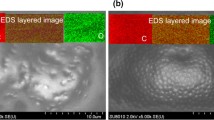Abstract
Structural features of a set of equipment for corrosion-mechanical and electrochemical studies of materials in a high-temperature aqueous medium are described. The autoclave equipment, in contrast to the known one, allows one to clear the working electrode in the medium at high temperature under pressure and to investigate the electrochemical processes on the freshened surface. Special attention is paid to the features of the methodical approach to the choice of the type of a design and to the implementation of electrochemical experiments.
Similar content being viewed by others
References
V. I. Pokhmurskii. I. P. Gnyp. A. A. Popov, et al.. “Methodical aspects of autoclave testing of compact specimens for cyclic cracking resistance.”Fiz.-Khim. Mekh. Mater..20. No. 1. 81–83 (1984).
V. I. Pokhmurskii. I. P. Gnyp. I. N. Antoshchak. et al..Laboratory Autoclave for Performing Electrochemical Investigations of Materials [in Russian]. Information Leaflet No. 88–018, TsNTI. Lviv (1988).
I. P. Gnyp and I. Z. Dutsyak. “Sensor for measurement of displacements under conditions of the action of corrosive media, high temperatures, and pressures,”Zavod. Lab., No. 10. 81–82 (1986).
W. H. Cullen. R. E. Taylor, and H. E. Watson. “Operation of the kinetics of a fatigue crack in aqueous media at increased temperatures and pressures in a high-temperature pressurized water fatigue crack growth system.”Mag. Mech. Testing,10. No. 2, 3–14 (1980).
RD-50-345-82.Methodical Instructions. Calculations of Strength and Strength Testing. Methods of Mechanical Testing of Metals. Determination of Characteristics of Cracking Resistance (Fracture Toughness) under Cycling Loading [in Russian], Izdatel’stvo Standartov, Moscow (1983).
“ASME boiler and pressure vessel code.” in:American National Standard. Rules for Inservice Inspection of Nuclear Power Plant Components, Section XI. ASME, New York (1992), pp. 221–241.
I. P. Gnip. A. A. Popov, I. Z. Dutsyak, and V. M. Timonin, “Effect of the character of interruption of experiments on the rate of growth of cracks in the hull steel under cyclic loading in a high-temperature reactor water.”Zavod. Lab., No. 5. 74–76 (1987).
I. Z. Dutsyak,Determination of Cyclic Cracking Resistance of Steels of Power-Generating Equipment in Water with Operating Pa- rameters for Calculation of Resource of Its Operation [in Russian], Author’s Abstract of the Candidate Thesis (Engineering). L’viv (1990).
I. L. Rosenfel’d, K. I. Afanas’ev, and V. A. Marichev, “Investigation of electrochemical properties of newly formed surfaces of metals in electrolyte solutions,”Fiz.-Khim. Mekh. Mater.,16, No. 6. 49–54 (1980).
L. N. Petrov. V. N. Tishchenko, and A. S. Chistov, “Corrosion-electrochemical factor in development of corrosion cracks under stress,”Fiz.-Khim. Mekh. Mater.,15. No. 4. 20–25 (1979).
L. N. Petrov, I. P. Osadchuk. and V. N. Tishchenko. “Procedure for obtaining a newly formed surface under fracture of a metal specimen through the stress concentrator in electrolyte.”Zavod. Lab., No. 5. 68–69 (1983).
E. Brauer and B. Schurich, “A new method for measuring the kinetics of repassivation of titanium,”Ber: Bunsenges. Phys. Chew.,85. No. 4. 313–318(1981).
I. Z. Dutsyak and I. N. Antoshchak. “Setup for investigation of corrosion properties of newly formed surfaces.” in:Materials of the 2nd Conf. of Young Scientists and Specialists “Problems on Improving the Quality of Materials. Instruments, and Equipment, ” Section Physicochemical Mechanics of Materials [in Russian], L’viv (1986), p. 26–30. Deposited at the All-Union Inst, of Sci. and Tech. Inform. 27.04.87. No. 3007-V87.
Tsujino Bunso and Miyase Sunao. “On area ratio of anode to cathode for iron in neutral solution,”Corrosion,37, No. 9. 540–545 (1981).
Sugimoto Katsuhisa, “Reference electrodes for aqueous solutions at high temperatures and pressures and their use in corrosion studies,”Boshoku Gijutsu, Corns. Eng.,29. No. 10, 521–533 (1980).
Matsumoto Keiichi and Sohinochara Takanobu. “Designing of electrochemical equipment for investigations at high temperature and high pressure and its use for solving the problems of corrosion of chemical equipment.”Boshoku Gijutsu. Corros. Eng.,33. No. 7. 381–386(1984).
M. V. Koval and R. K. Melekhov, “Autoclave for electrochemical measurements at temperatures of up to 473 K and pressures of up to 4MPa.”Fiz.-Khim. Mekh. Mater.,18. No. 2. 117–118(1982).
A. Ya. Shatalov,Introduction to Electrochemical Kinetics [in Russian], Vysshaya Shkola, Moscow (1984).
D. Macdonald Digby and C. Scott Arthur.Pressure Balanced External Reference Electrode Assembly and Method [Electric Power Research Institute. Inc.], US Patent G01 No. 27/30. No. 4273637. Applied 23.01.80. No. 114618. Published 16.06.81.
A. K. Agraval and R. W. Staehle. “Silver-silver chloride reference electrode for the high temperature electrochemistry,”Corrosion. 33, No. 11. 418–419(1977).
I. V. Monter. I. P. Sorenson. and G. I. Theus,High Temperature Reference Electrode [The Babcock & Wilcoz Co.], US Patent. Class 204/195F (G01 No. 27/03). No. 4290872. Applied 28.06.79. No. 52888. Published 22.09.81.
I. P. Gnyp and I. M. Antoshchak, “Effect of metallurgical and electrochemical factors on cracking of steels for nuclear power plants at high temperatures,”Probl. Prodi. No. 3. 63–71 (1996).
I. P. Gnyp. V. I. Pokhmurs’kyi. and I. M. Antoshchak. “Analysis of the influence of nonmetallic inclusions on corrosion cracking resistance of steels,”Fiz.-Khim. Mekh. Mater.,28. No. 4. 28–35 (1992).
V. I. Pokhmurskii. I. P. Gnyp. and I. N. Antoshchak, “Electrochemical properties of steels for nuclear power plants in reactor water at 9O-3OO‡C.”Zashch. Met.,30, No. 3. 271–275 (1994).
Author information
Authors and Affiliations
Additional information
Translated from Fizyko-Khimichna Mekhanika Materialiv, Vol. 36, No. 3, pp. 67–73, May-June, 2000.
Rights and permissions
About this article
Cite this article
Antoshchak, I.M., Gnyp, I.P. Equipment and method for autoclave corrosion-mechanical and electrochemical investigations. Mater Sci 36, 392–400 (2000). https://doi.org/10.1007/BF02769600
Received:
Issue Date:
DOI: https://doi.org/10.1007/BF02769600




